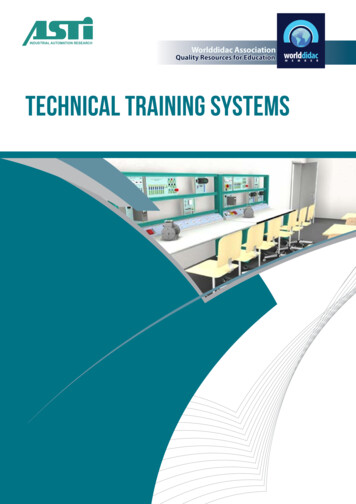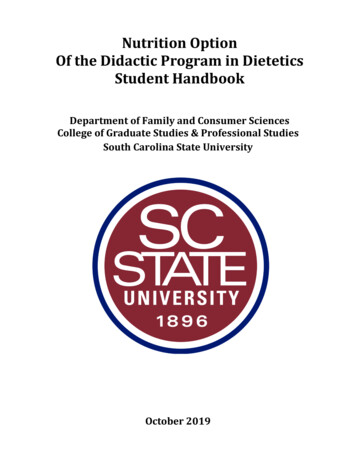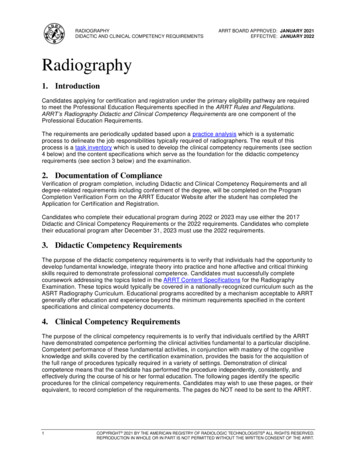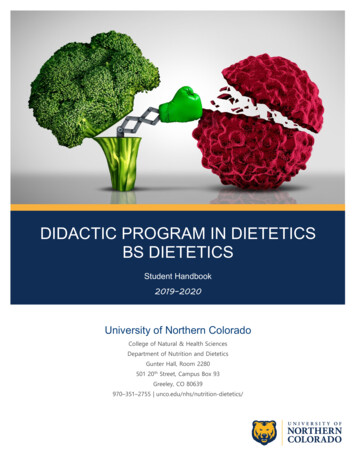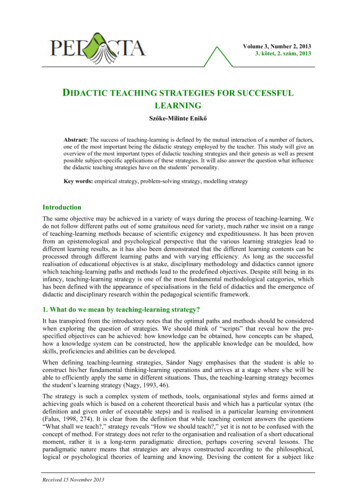
Transcription
Volume 3, Number 2, 20133. kötet, 2. szám, 2013DIDACTIC TEACHING STRATEGIES FOR SUCCESSFULLEARNINGSzőke-Milinte EnikőAbstract: The success of teaching-learning is defined by the mutual interaction of a number of factors,one of the most important being the didactic strategy employed by the teacher. This study will give anoverview of the most important types of didactic teaching strategies and their genesis as well as presentpossible subject-specific applications of these strategies. It will also answer the question what influencethe didactic teaching strategies have on the students’ personality.Key words: empirical strategy, problem-solving strategy, modelling strategyIntroductionThe same objective may be achieved in a variety of ways during the process of teaching-learning. Wedo not follow different paths out of some gratuitous need for variety, much rather we insist on a rangeof teaching-learning methods because of scientific exigency and expeditiousness. It has been provenfrom an epistemological and psychological perspective that the various learning strategies lead todifferent learning results, as it has also been demonstrated that the different learning contents can beprocessed through different learning paths and with varying efficiency. As long as the successfulrealisation of educational objectives is at stake, disciplinary methodology and didactics cannot ignorewhich teaching-learning paths and methods lead to the predefined objectives. Despite still being in itsinfancy, teaching-learning strategy is one of the most fundamental methodological categories, whichhas been defined with the appearance of specialisations in the field of didactics and the emergence ofdidactic and disciplinary research within the pedagogical scientific framework.1. What do we mean by teaching-learning strategy?It has transpired from the introductory notes that the optimal paths and methods should be consideredwhen exploring the question of strategies. We should think of “scripts” that reveal how the prespecified objectives can be achieved: how knowledge can be obtained, how concepts can be shaped,how a knowledge system can be constructed, how the applicable knowledge can be moulded, howskills, proficiencies and abilities can be developed.When defining teaching-learning strategies, Sándor Nagy emphasises that the student is able toconstruct his/her fundamental thinking-learning operations and arrives at a stage where s/he will beable to efficiently apply the same in different situations. Thus, the teaching-learning strategy becomesthe student’s learning strategy (Nagy, 1993, 46).The strategy is such a complex system of methods, tools, organisational styles and forms aimed atachieving goals which is based on a coherent theoretical basis and which has a particular syntax (thedefinition and given order of executable steps) and is realised in a particular learning environment(Falus, 1998, 274). It is clear from the definition that while teaching content answers the questions“What shall we teach?,” strategy reveals “How we should teach?,” yet it is not to be confused with theconcept of method. For strategy does not refer to the organisation and realisation of a short educationalmoment, rather it is a long-term paradigmatic direction, perhaps covering several lessons. Theparadigmatic nature means that strategies are always constructed according to the philosophical,logical or psychological theories of learning and knowing. Devising the content for a subject likeReceived 15 November 2013
50Szőke-Milinte EnikőCommunication also raises the issue of paradigms, although it has to be clear that apart from thescience logical paradigms, learning theory paradigms also play a crucial role when devising andprocessing the content for school materials. The mutual relationship between the paradigms of thelogic of science and theories of learning poses a separate problem which is primarily faced bycoursebook writers and teachers organising and realising the process of teaching-learning.A strategy is a long-term definition of a general direction that encompasses design, supervision,management as well as the system of the applied processes and their appropriate instructions. Ingeneral, the management and supervision of several areas of the economy and society presuppose thedesign, organisation, direction, monitoring and evaluation of the given activity, namely, thedevelopment of a comprehensive strategy considering the functioning and operation of the entiresystem. Therefore, we can state that strategy is a category in a general methodological sense.When examining the nature of the strategies in the teaching-learning, we have to uncover the effectiveways and means of the functioning and operating of the educational process which lead to thesuccessful realisation of the didactic activity. We have to construct such teaching-learning models thatare supported by well-defined learning theoretical paradigms and facilitate the processing ofeducational content in the interest of the predefined objectives. Thus, strategies are well-definedmeans of activity orientating the process of learning which, due to their internal logic, allow for theselection and construction of methods, tools, processes and organisational forms while represent afundamental pedagogical approach (Ferenczi and Fodor, 1996, 82-84)1.1. Empirical strategyEducational strategies were brought along by the discovery that learning can be realised through avariety of ways, down various paths with different results. The fundamentals of empiricism weredefined by English empirical philosophers, such as Francis Bacon or John Locke, in the 17th and 18thcenturies. They believed that human acquisition of knowledge is but the reception of realitysurrounding man through the senses. The main source of knowledge is experience, we become toknow the world and acquire knowledge through our senses. While accruing the simple facts andphenomena of reality, man is simultaneously obliged by the same facts and phenomena to realiseconnections and, based on these, to deduce generalisations and abstractions. This is how conceptsreflecting reality and the relationships within reality and, in turn, further generalisations lead to thediscovery of laws and principles. In this experiential philosophy the criterion of the truth of knowledgeis empirical confirmation, namely, all knowledge is true which holds up to empirical testing. Mananalyses experience gained through perception, therefore the process of experiential learning isinductive, and acquiring knowledge is considered to be moving from the simple to the complicated,from the particular to the general, from the concrete to the abstract (Figure 1.) (Nahalka, 2001, 205 ).Empiricism is the first epistemology, theoretical framework for the description of knowledge andlearning, which, apart from having generated still solidly holding views and methodological processesin pedagogy, has provided a complete theoretical paradigm for the construction of didactics. Thesystematic pedagogy based on empiricist epistemology was constructed by Herbart in the 19th century.He defined the process of learning in the following stages:a) The teacher presents the concrete manifestations of the new knowledge, which Herbart calls staticreflection.b) The crystallised concept clusters soon propel into action the concepts already stored in theconsciousness. This upsets the existing order and – through association –similar concepts from the oldand new stock come into contact with each other. This is the dynamic phase of reflection.c) The concept clusters reinforced by the associations come into contact with the concept clustersalready embedded into the consciousness plane. This is static consciousness.d) The new concept cluster takes root properly when the consciousness plane is reactivated: the newconcept cluster collides with the already embedded concept clusters through comparison, applicationand practice. This is what Herbart calls dynamic consciousness. (Mészáros and Németh andPukánszky, 2000, 146-152). Although Herbartian pedagogy has been widely criticised, it hasinfluenced educational practice up until today. Nowadays one of the most frequently used educationalPedActa, ISSN: 2248-3527
Didactic Teaching Strategies51strategies applied in teaching communications derives from this pedagogical paradigm: empiricalstrategy.Figure 1. The process and system of acquiring knowledge according to objectivist theory of knowledgeWe often see that a teacher instinctively applies this strategy without previous planning or preparation,and can do so because the knowledge theory strategy is very close to both the natural form of humanknowledge acquisition and the characteristics of scholarly learning (Falus, 2003, 243-293., Ollé,2010, 137). It can also be observed that whether the teacher centres on his/her own activities orfocuses on learners’ activities when applying the strategy result in very different learning experiences.In the case of the latter, the learner profits much more from the teaching-learning strategy since s/hecan be the protagonist of his/her own learning/knowledge acquisition activity. Due to the influence ofthe activity-centred paradigm, these days this latter form of the empirical strategy could be morerecommended for didactic activities.A teacher of communication will shape the knowledge theory strategy in the following steps:-Collection of factual material – recognition of the basic concepts of the studied phenomenon inconcrete situations, observation, recognition and focus on typical characteristic and facts arising fromthe situations. (For example, viewing a communicative situation in a short film extract together withthe students at the beginning of the lesson then observing and recognising the studied phenomena inthis situation.)-Conceptualisation – definition of new concept as a result of observing facts and phenomena (forexample, the definition and naming of the recognised phenomenon – strategy of cooperation)-Repetition and classification – categorisation of the studied and recognised phenomena and conceptsaccording to new, higher levels of abstraction, that is to say, this is not a simple regurgitation of thematerial learnt in class.-Application and practice – the practical application of the recognised and acquired concepts, rules andlaws with the aim of turning this application into skills (for example, the analysis of communicativesituations according to types of communicative problems).-Assessment and evaluation – a didactic momentum of feedback and regulation which informs boththe learner and the teacher about how the learner’s knowledge has been shaped during the learningprocess (knowledge, skill, proficiency and ability system). At the same time the performance alsoreflects the efficiency of teaching-learning provided it is not a product of the learner’s individualefforts, but it also depends on the quality of the tasks organised by the teacher and completed by thelearner community.Volume 3 Number 2, 2013
52Szőke-Milinte EnikőAs an example, let us review the following empirical strategy plan for the curriculum section on “The perfection ofself-recognition” (Dr. Raátz Judit and Dr. Szőke-Milinte Enikő. 2010. Üzleti kommunikáció. Budapest: NemzetiTankönyvkiadó. 123-127).1. At the beginning of the class the teacher offers the students various communicative situations for analysis with theaim that the students collect sufficient and adequate material regarding the phenomena under examination.SituationsTeachers’ questionsVender: I’m sorry, we don’t have millet cake.Howwouldyouqualifythecommunication? How does s/he react?Customer: What a place! Let’s go.Who and when will react in a similar manner?Customer’sWhat kind of Customer will communicate like this?Vender: I’m sorry, we don’t have millet cake.Howwouldyouqualifythecommunication? How does s/he react?Customer’sCustomer: That’s a pity/So am I.Who and when will react in a similar manner?What kind of Customer will communicate like this?Vender: I’m sorry, we don’t have millet cake.Customer: Well, a patisserie with such reputationperhaps should pay more attention to marketdemands.Howwouldyouqualifythecommunication? How does s/he react?Customer’sWho and when will react in a similar manner?What kind of Customer will communicate like this?2. The teacher names the Ego-States which are defined together with the learners also describing the characteristicsof the various Ego-States. The teacher presents Berne’s personality model and the concept of transaction, that is, s/hecompletes conceptualisation in this strategic stage.3. Repetition and classification happens through the presentation of the transactional model of the previouscommunicative situations where the learners, supervised by the teacher, can discover the dynamics of the situation,identify the communicators’ transactions and Ego-States (draw the missing transaction and identify thecommunicator’s Ego-State: child, adult, parent).I’m sorry, we don’t have millet cake.What a place! Let’s go.4. During the stage of application and practice, the learners have to recognise the concepts they have acquired in anew communicative situation and analyse the situation with the use of these concepts.Please read the following dialogue!At the customers services of a cable television service provider:Client: What were you thinking? You can just cut the service without any notice? Without aword?!Customer service representative: You haven’t fulfilled your responsibilities signed in thecontract, and haven’t paid the service charges for over three months.Customer: Maybe because I’ve never received the bill!!Customer service representative: Consider how the customer service representative would reply in different Ego-States? As a critical parent As a rebellious child As an adultDiscuss which answer would be the correct one from a communicative perspective! Why?5.The teacher assigns a new communicative situation as homework and asks the learners to give a transactionalanalysis of this situation.PedActa, ISSN: 2248-3527
Didactic Teaching Strategies53The stages of empirical strategy together with a learner-centred approach can lead to impressiveresults in teaching communication. What does this mean? The learners collect, classify and evaluatethe factual material, they may assume conceptualisation tasks, they repeat and classify the newlyacquired knowledge in new task situations according to new perspectives, then apply and practice thesame in particular situations and reflect on their own and others’ activities. The teacher coordinates,supervises, assists, facilitates, complements the learners’ activities as well as draws attention toparticular points and evaluates their performance.1.2. Problemsolving strategyAt the beginning of the 20th century there was an upsurge in the research on learning and acquisitionand complex learning theories were born. One of the most important psychological epistemologies isassociated with Piaget who considered activity in a psychological sense, which comprisespsychological operations and actions, the key condition of the development of mental abilities. In histheory, Piaget uncovers the similarities between material and intellectual activities as well as thepresumable identities of development, and describes the mental operations and their developmentalstages. He illustrates two essential processes of mental assimilation, which are: the process ofincorporation of a new element (piece of information) into the already existing psychological scheme(system); and accommodation which is the integration (framing) of the existing psychological schemes(structures) to the new element (piece of information), which results in the restructuring of thepsychological structure (Piaget, 1997, 19-22 and 142-152). Thus, it is the learning individuals’ activitytakes centre stage. At the same time it is worth considering that the description of the endeavour toachieve a balance between the organism and its environment goes far beyond the recognition of thesignificance of the activity and projects the process of mental construction which forms the basis ofcognitive sciences.Early cognitive psychology contributed to the emergence of the various schools of thought onacquisition by interpreting the operations of human reason as information processing. The humanmind features as a problem-solving being that manipulates symbols and reacts to the changes of theoutside world in an intelligent manner. The first cognitivist definition of problemsolving can beattributed to Newel and Simon who considered the importance of the recognition and analysis of theproblematic situation. They believed that a number of stages were necessary to solve a problem,including: the collection and examination of data, the construction of solution plans and their testing,empirical revision and, finally, the actual solution of the problem (Nahalka, 2001).The learning theoretical paradigm, which has become to be known as action psychology, as well as theearly cognitivist knowledge theoretical paradigm together form the basis of an important teachinglearning strategy which has emerged in pedagogy, namely, problemsolving strategy (Nagy, 1993, 4654, Falus, 2003, 243-293.). A fundamental characteristic of human thinking and learning is that it isunsettled by an unknown environment, and that it poses questions with regard to the subject oflearning, and subsequently acquires new knowledge by seeking out and defining new possibleanswers. It is easy to acknowledge that the attitude of learning is necessarily the attitude of raising theproblem.It is a characteristic of the problem that already existing system of knowledge and skills is insufficientfor the resolution of the problem and for the answering of the basic problem question. Therefore, thelearning subject is necessarily obliged to acquire new knowledge, to navigate new (heuristic) mentalpaths and to discover new solutions. Eliminating the problematic situation or solving the problem canonly be achieved through mental effort and extra labour.Apart from requiring mental involvement, another significant virtue of the problemsolving strategy isthat the moments of recognition and application cannot be separated, since the approach is rooted inthe learning nature of the activity. An active acquisition of knowledge presupposes rediscovery andthe passage through the various stages of learning, that is, the completion of such mental operationsand actions through which new information can be obtained and new connections can be recognised.The application of the strategy is complicated by the fact that it is difficult to make the possibleproblems uniform in the sense that it depends on the individual’s development what constitutes aVolume 3 Number 2, 2013
54Szőke-Milinte Enikőproblem (there are children who will not consider the proposed problem a problem anymore, and thereare others for whom it is still not a problem). Therefore, besides differentiation, the question ofmotivation becomes significant in the applicability of the problemsolving, since the problematicsituation presupposes much more complex psychological structures and operations, and the problemmay present as a serious source of conflict for the learner. The learner has to be stimulated to use thetension positively and to endure the sometimes long and arduous journey that is problemsolving.The stages of problemsolving teaching-learning strategy are as follows:-The creation of a problematic situation-The analysis and synthesis of the problem, the definition of the key problem question-The construction of the problemsolving plan-The recognition of the unknown in the problem-The execution of the corrections arising during the process of problemsolving-The synthesis of the information obtained during the parts of the problem-The answering of the key problem question-The outlining of the new problem (Ferenci and Fodor, 1996)The process of problemsolving presupposes divergent thinking and the construction of heuristics planswhich do not prescribe strict rules and a definitive order of the various stages, but rather presupposeoriginality, free combinative possibilities and creative imagination. During the process of searching forthe solution the learner actively processes and rediscovers the information, which presupposesdevising learning content according to task and problem systems. The strategy also earmarks aparticular role for the teacher: s/he coordinates, organises and manages the process of problemsolvingand makes the learner recognise the problem as well as the various stages of the problemsolvingprocess.Let us review the possible applications of problemsolving with the aid of an example. The subject of the lesson:“Preparation for effective communication” (Type of school: vocational secondary school, Year: 2, Subject: BusinessCommunication). The process of teaching is as follows:Watching a film about Sándor Csányi (Kiút (“Way out”) –Sándor Csányi, bank CEO, Kettőspont Alapítvány és aKultindex Nonprofit Kft. 2010. http://www.youtube.com/watch?v EP71DOXfqKY, accessed 01.11. 2013.)Key problem: Under what conditions can someone become a successful person? During the class discussion learnersdefine the answer. In case they need assistance, the teacher may help with the definition of the problem.Prior to studying the chapter, immediately before class, the students carried out a case study in groups and completed thefollowing tasks:1. Collect data about childhood and studies of the individual under study!2. Collect as much data as possible about his/her professional career! Study his CV!3. Look for a video about the individual in question and try to assess his/her temperament, special skills, particularknowledge!4. Look for interviews with the individual in question! Based on these, identify his/her interests and beliefs!5. Look for information on the internet which sheds light on his/her future plans!6. Collect information from which you can deduce his/her attitudes!7. Determine how many roles this individual plays at the moment!8. Find some examples to support how s/he is success-oriented!9. Collect information about his/her role models and best connections from the interviews, CV or other sources!10. Assess his/her communication style!11. Collect serious problems which have affected this individual one way or another! Present how s/he has participatedin solving the problem!12. Look for events which exemplify how this person takes responsibility of his/her social environment! Commend theseevents!The students outline the various elements of the key problem with the teacher’s help: they define these elements basedon the tasks they have completed (e.g. the relationship between skills and individual success; the role of the family inplanning and living a successful life) which are related to the key problem and help understanding and solving the same.The students report back on the results, the teacher manages the discussion.The teacher and the learners summarise the possible answers according to the key problems.The teacher together with the learners constructs the possible solutions to the problem (in writing, if necessary).During the follow-up classes the detailed discussion concentrates on the preparation resulting in success (c.f. Dr. RaátzJudit and Dr. Szőke-Milinte Enikő. 2010. Üzleti kommunikáció. Budapest: Nemzeti Tankönyvkiadó.103-154).PedActa, ISSN: 2248-3527
Didactic Teaching Strategies551.3. Modelling strategyFrom the second half of the 20th century, cognitive sciences have pursued the description of learningas modelling, and considered individual learning as a model-creating activity. In the constructivistlearning theory paradigm, learning is an active process, an important momentum of which isinterpretation, whereby the learning individual interprets new information with the help of his/herknowledge organised in cognitive systems. The learner’s previous knowledge plays an important rolein this process, which exists in the form of a so-called “naïve theories,” worldviews, constructedtheoretical systems or models in the learner’s consciousness, since these are the elements that comeinto contact with the new information. Thinking and learning do not happen in a vacuum becauseelements of knowledge already at the child’s disposal significantly influence, or even more direct, thecognitive processes. According to the constructivist learning approach, the learner does not simplyincorporate new knowledge, s/he rather constructs it, which means that learning is a continuousformation of the internal world (Nahalka, 1997).In line with the constructivist learning approach, the functioning of the human mind can be understoodthrough modelling. Consequently, we construct our structures and models of the world, ourenvironment according to our own rules, the role of which is to predict events in the world and theresults of our actions, thus, we can control and regulate our own actions (Carey and Spelke, 1994;Nahalka, 2002).The most important tenets of constructivism are as follows:-The human mind constructs a model of reality, and evaluates and acts accordingly.-The human brain operates with the help of apparatuses which process information organisedaccording to various knowledge areas.-A person has “theories” useful to evaluate his/her environment and control his/her actions.-Development is nothing but the constant change, modification, extension and enrichment ofconstructions and worldviews operating in the brain, that is, a series of “conceptual changes” (ourinternal constructions change due to the processing of new information; continuous differentiation ofthe already existing principles; see Figure 2.) (Falus, 2003, 120-120).Worldview construction1new informationworldview construction 2Figure 2. The process of the development of knowledgeTherefore, we consider models such human-made theoretical systems that reflect the defining featuresof a given object or phenomenon of reality in a given place at a given time as a result of abstraction,generalisation, formalisation and schematisation following an individual process of learning.Supposedly, the psychological model and the examined reality are in an analogical relationship. Froma teaching theoretical perspective, the constructive learning paradigm has resulted in the devising ofthe modelling strategy.The first phase of the process of modelling is the devising of psychological or ideational models, thatis, we try to map the subject of learning with its own structure and dynamics at an intellectual levelthrough the already existing mental constructions. These ideational models are realised throughinternal talk and have a knowledge theoretical value. Ideational models are malleable and dynamic,while complex at the same time, and simultaneously comprise projected images, concepts, conclusionsand relationships with regard to the subject of learning. They are not photocopies, identificationbetween reality and the ideational model cannot be assumed.In the next phase, we materialise the ideational models, which formally occurs through visualelements, symbols and signs (codes), that is, the materialised model attempts to represent the essentialelements of the modelled object concurrently. This comprehensive, simultaneous and schematisedmodel permits the learner to uncover the interrelationship between the studied elements at a deeperlevel, and in some cases allows for the testing of concrete actions on a model. The construction ofthese is made possible through abstraction, although they are not as complex and dynamic as theideational models. Their advantage is that the structure and operation of the intellectual systembecomes accessible, thus, the teacher can be informed about the child’s possible deficiencies or theVolume 3 Number 2, 2013
56Szőke-Milinte Enikőprocess of thinking. They also allow us to carry out actions on them, or to clarify world models, and tocreate several model variations in order to arrive at a more precise analysis.The third phase of modelling is the devising of verbalised models. They can be derived from theideational models through exteriorisation, and they represent the highest level of abstraction.In case ofverbalised models, the higher we move from the lower levels of abstractions, the more the essentialvalue of the phenomena increases, words become the tools of thinking. The structure and generativerules of the languages reflexively influence thinking, and thus, the process of modelling (Ferenci andFodor, 1996).Verbal modelIdeational modelMaterial modelFigure 3. The process of modellingModelling strategy can follow two different paths (Figure 3.). During the process of learning weprocess the new, unknown information with the aid of the existing reality constructs, and devise newworld model constructs. We shape both the processing of information and the process of creating anew world model as well as the actual new world model into a verbal model in order to make ourprocesses of learning and their results available to others. Ideational models manifest in verbalisedmodels, thus they ensure the accessibility of knowledge and the development of learning.In case any problems arise during the process of learning, an intermediary step becomes necessary:that of the devising of materialised models. Materialised models can present several perspectivessimultaneously, thus contributing to comprehension and the creation of a successful model. Once thematerialised models have settled and crystallised, they are verbalised, while the process and result oflearning are put into a linguistic form.A good example of the application of modelling can be found on page 274 of Üzleti kommunikáció (Raátz andSzőke-Milinte, 2010):Pl.Create a business in groups of five. Design the profile, image and main activities of the venture! Prepare a fewadvertisement
Received 15 November 2013 Volume 3, Number 2, 2013 3. kötet, 2. szám, 2013 DIDACTIC TEACHING STRATEGIES FOR SUCCESSFUL LEARNING Szőke-Milinte Enikő Abstract: The success of teaching-learning is defined by the mutual interaction of a number of factors, one of the most important being the didactic strategy employed by the teacher.







